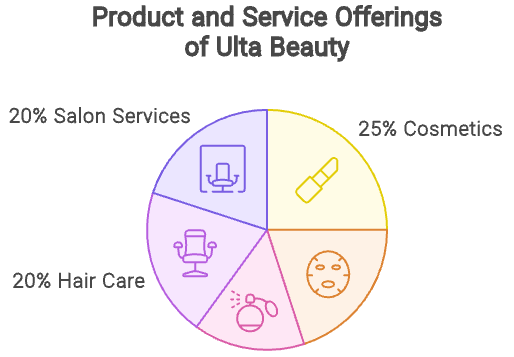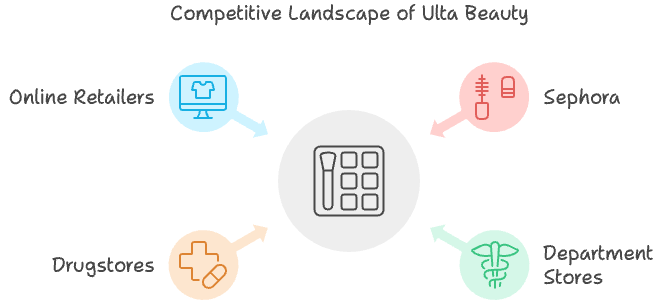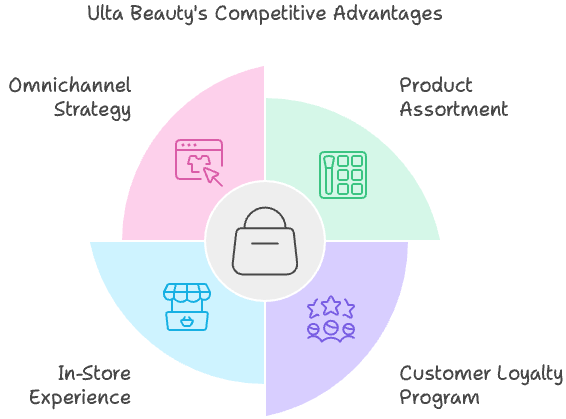- AiartGallerie(Invest)'s Newsletter
- Posts
- The Ultimate Guide to Ulta Beauty: Dominating the U.S. Beauty Retail Market
The Ultimate Guide to Ulta Beauty: Dominating the U.S. Beauty Retail Market

Introduction
Ulta Beauty has emerged as a dominant force in the U.S. beauty retail market, blending prestige and mass-market cosmetics under one roof. With a robust business model, strategic growth, and a loyal customer base, Ulta has carved out a unique niche. But how did they achieve this, and what keeps them on top in such a competitive landscape?
In this newsletter, we’ll dive deep into Ulta Beauty’s business model, financial performance, market position, competition, and key industry trends driving its success. By understanding these factors, you’ll gain insight into why Ulta continues to thrive in the ever-evolving beauty industry.
Company Overview
A. History and Background
Founded in 1990 by Richard E. George, Ulta Beauty was born out of a vision to create a beauty store that offered both high-end and drugstore brands under one roof. The first store opened in Illinois, and the company has rapidly expanded since.
In 2007, Ulta went public (NASDAQ: ULTA), accelerating its growth and transforming from a discount beauty retailer into a full-service beauty destination. Today, Ulta combines retail and salon services, revolutionizing how consumers shop for beauty products.
B. Business Model
Ulta’s business model stands out by offering a "one-stop-shop" experience with both luxury and affordable beauty products. Here’s what they offer:

Cosmetics: A mix of prestige and mass-market makeup brands like MAC, Urban Decay, and Maybelline.
Skincare: Leading skincare brands like Clinique and The Ordinary.
Fragrance: Luxury perfumes like Chanel and Dior, alongside more affordable options.
Hair Care: Brands like Redken and Dyson, catering to both professionals and everyday consumers.
Salon Services: Haircuts, coloring, and styling services to enhance the in-store experience.
Market Position
A. Financial Performance
Ulta’s financial performance has consistently outpaced expectations, driven by strong same-store sales and expansion into new markets.

Revenue Growth: Consistent year-over-year growth supported by e-commerce and physical stores.
Profit Margins: High margins from private-label products and salon services.
E-commerce Growth: Ulta’s digital platform has become a key growth driver, especially post-pandemic.
B. Store Footprint
Ulta operates over 1,200 stores across the U.S., with expansion plans in untapped and existing markets. Their suburban and shopping center locations are accessible to a broad customer base.
Competitive Landscape
A. Key Competitors
Ulta faces competition from a mix of brick-and-mortar and online players:

Sephora: Ulta’s closest competitor, focusing more on luxury brands.
Department Stores: Macy’s and Nordstrom’s beauty sections cater to high-end buyers.
Drugstores: Chains like CVS and Walgreens sell beauty products but lack Ulta’s in-store experience.
Online Retailers: Amazon and beauty-specific platforms like Glossier compete online, but Ulta’s omnichannel approach gives it an edge.
B. Competitive Advantages
Ulta’s success can be attributed to several competitive advantages:

Product Assortment: A broad range of products at varying price points.
Customer Loyalty: The Ultamate Rewards program drives significant customer retention.
In-Store Experience: A unique blend of retail and salon services.
Omnichannel Strategy: Seamless integration of online and offline shopping experiences.
Industry Trends
A. Growth Drivers
Key trends driving the beauty industry’s growth:
Innovation: Ulta offers cutting-edge products and collaborates with emerging brands.
Consumer Trends: Growing demand for clean beauty and personalized products, which Ulta caters to.
Digital Transformation: Ulta’s digital marketing and influencer partnerships drive online sales.
B. Challenges
Challenges Ulta faces moving forward:
Economic Uncertainty: Economic fluctuations could impact consumer spending on beauty products.
Supply Chain Issues: Supply chain disruptions affect product availability.
Competitive Pressure: New competitors are constantly entering the market, pushing Ulta to stay innovative.
Conclusion
Ulta Beauty has built an empire by understanding customer needs and adapting to industry trends. Its unique business model—combining retail and salon services—along with a wide range of product offerings, has positioned it as a leader in the beauty industry.
With strategic growth, a strong omnichannel presence, and a focus on customer loyalty, Ulta has consistently outperformed its competitors. As the industry continues to evolve, Ulta’s ability to innovate and adapt will be key to maintaining its dominance.
Stay Ahead of Stocks Investment Ideas and Knowledge – Subscribe Today!

Stay ahead in the dynamic world of stock investments! Subscribe now to our newsletter and get the latest insights and trends in the financial markets delivered straight to your inbox. Be informed about the revolutionary advancements and investment opportunities that are reshaping our digital and economic landscapes. Click here to subscribe - Your future self will thank you!
Looking forward to our next update,
AiartGallerie
Reply